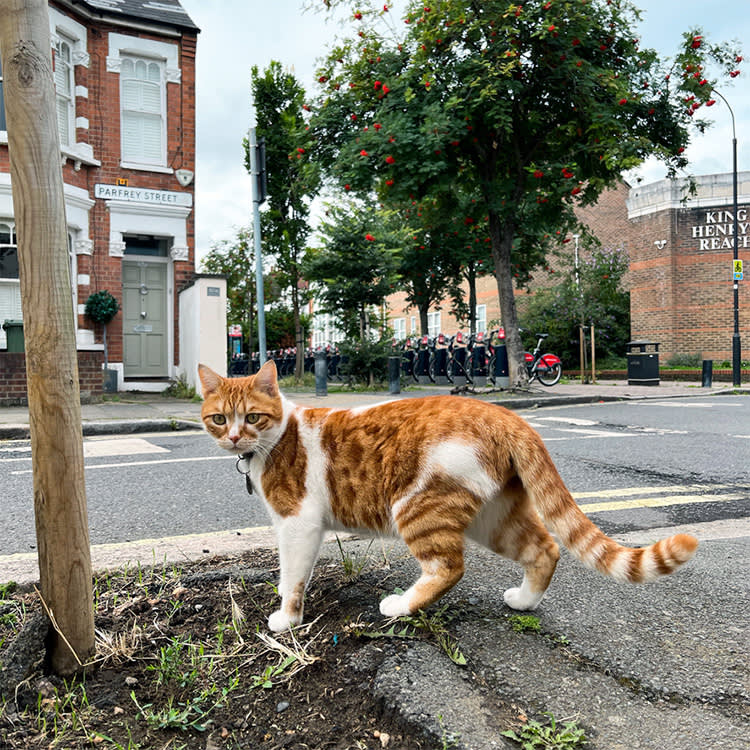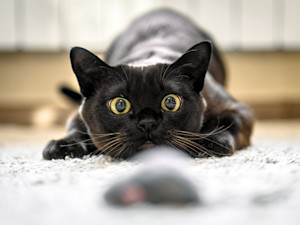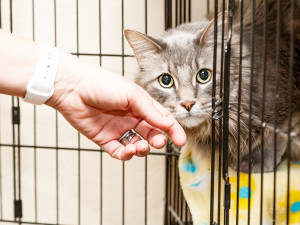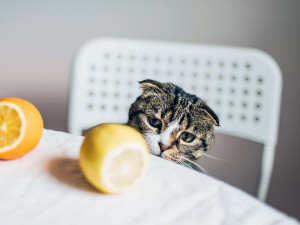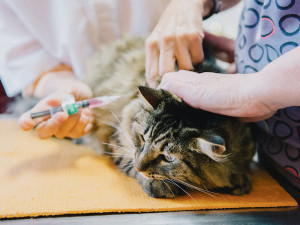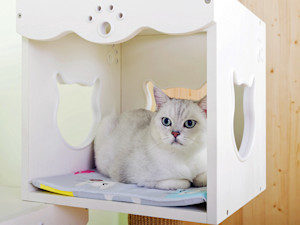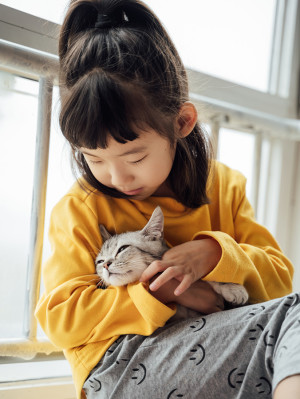Is It Safe to Have an Outdoor Cat in the UK?
Free-roaming felines are much more common here than in other parts of the world – we uncover the reasons why
A few weeks ago, I was watching an Instagram reelopens in new tab showing the real-life story of friendship between two neighbouring cats whose bond grew over time. Cute, right? The video culminated in a shot of the cats playing on a roof next door. ‘How heartwarming,’ I thought – then I looked at the comments. Hundreds of people were horrified at the fact the protagonist cat had left the confines of the garden, and the comments (and mini lectures) ranged from outrage to concern. The original poster had to clarify that this video was filmed in the UK, and that we have different approaches to letting our cats free roam. So why are we an outdoor cat nation and what are the differences between our cat culture and those of our feline-loving friends around the world?
Why do we let cats free roam?
Although domestic cats have lived on UK shores and in our homes for over a thousand yearsopens in new tab, and have been domesticated as a species for even longer (around 12,000 yearsopens in new tab), their hunting and roaming instincts are still very much hardwired into their DNA – despite their best efforts to convince us otherwise from the comfort of their heated cat beds. “Cats are still able to survive in the wild despite their adaptability to cohabit with us in a domestic setting,” explains veterinary nurse and cat behaviourist Zoe Blakeopens in new tab.
Get (totally free) deals for food, treats, accessories, tech and way more pet parenting must-haves.
As a result of this intrinsic desire and innate survival ability, 70% of domestic catsopens in new tab in the UK live an indoor/outdoor hybrid lifestyle, with charities such as Cats Protectionopens in new tab and Batterseaopens in new tab actively recommending that cats have access to the great outdoors for their well-being (much like us needing our little daily walks for our mental health). Zoe explains that because cats are solitary survivors, they learn using both observational learning and trial and error, and when they have the opportunity to try something new and gain a positive outcome (like jumping over a garden fence), they remember that experience and adapt accordingly. “So with this in mind, allowing a cat to free roam could lead to a favourable outcome for their emotional and physical wellbeing,” she says.
In contrast, in the US, 70% of catsopens in new tab are kept indoors, or if they are let outside, it’s within the confines of a secure garden or catio (this is also for their well-being, but for different reasons, which we’ll get into later). Or take the town of Walldorf in Germany as an example, which previously had a fine in placeopens in new tab of up to €500 for cat parents letting their cat outside, due to the risk of death to the endangered ground-nesting crested lark – and those cat parents could even risk being fined up to €50,000 if their cat injured or killed one of the birds.
What are the reasons behind this difference?
There are a number of reasons why we approach things so differently in the UK when it comes to deciding whether to let our kitties indulge their natural instincts by roaming and hunting outside.
Geography
The UK’s relatively mild climate and abundance of green spaces makes it an ideal environment for outdoor kitty adventures. With plenty of parks, gardens and quiet streets to explore, cats in the UK are much safer than they might be elsewhere. In residential or rural areas, our roads tend to have low speed limits and low traffic, and our networks of back gardens provide plenty of territory for cats to explore without them needing to ever venture out on to the street.
However, it is important to note that the number one cause of deathopens in new tab for cats in the UK is trauma from road accidents, with Petplan reporting that 23,000opens in new tab cats are run over per year. As a result, some of the remaining 30% of cats who do live inside often live near busy roads, so their parents opt to keep them indoors to prevent these kinds of accidents. Many cat rehoming charities will even advise those living near busy roads to adopt a catopens in new tab who needs to stay indoors anyway for health reasons (if they have infectious diseases like feline leukaemia virus and feline immunodeficiency virus), rather than a cat who is used to going outside.
Predators
Coyotes, hawks, eagles, snakes, mountain lions, wolves, bears, cougars… this is not the long-winded title of a new David Attenborough doc, but a non-exhaustive listopens in new tab of potential predators that cats are at risk from in other parts of the world. If the image of your beloved kitty being attacked by any of the above is enough to break you out in a cold sweat, you’ll be able to relate to why responsible pet parents in other parts of the world keep their cats safe inside and away from these dangers.
In the UK, meanwhile, cats have a much more limited roster of potential predators, with birds of preyopens in new tab being the only real risk. However, they’re both extremely unlikely to attack full-grown cats (make sure you supervise kittens in the garden if you live in an area where birds of prey are more prevalent, hello Scottish Highlands) and are much rarer in general than in the US, for example. (For comparison, the most common bird of prey in the US is the red-tailed hawk with a population of 3.1 millionopens in new tab, versus 200,000 ospreyopens in new tab in the UK.)
Prey
As skilled hunters, cats were originally domesticated to keep mice and rat populations under control, which they still do, particularly in crop fields. But this hunting ability, impressive as it is, can have a seriously negative impact on wildlife populations (remember the fine in Germany for cats injuring endangered birds?). “Predation by cats is not among the biggest drivers of wildlife decline in the UK, but we know cats do kill birds in UK gardens,” a spokesperson for the RSPB told Kinship.
A study carried out by the Mammal Societyopens in new tab estimated that around 27 million wild birds are predated by domestic cats in the UK each spring/summer. However, as the RSPB explains, “This figure is likely to be an underestimate, as cat ownership rates have increased in the UK in recent years, and the study also only included prey that were known to have been caught.”
Although this is a very real threat to our bird populations, and the RSPB do have concerns that “cats can cause particular problems for vulnerable and restricted populations of birds, in particular birds that nest low to or on the ground that will be unable to defend their chicks,” the threat to endangered animal populations specifically is less significant in the UK in comparison to other countries. As Phillip Baker, a mammalogist at the University of Reading, saysopens in new tab, “Britain and Europe have had native wild cats for millennia, and therefore prey species have evolved alongside them.”
So is it safe for my cat to free roam?
This all comes down to individual circumstances and personal choice, the health of the cat, the area you live in and the outdoor space you already have available (a cat in a flat, for example, might be more inclined to wander the streets than a cat who has access to a big garden). “A cat’s surroundings indicates the risks they may be faced with: road traffic collisions, cat fights, infectious diseases [feline leukaemia virus (FeLV), feline immunodeficiency virus (FIV) and bartonellosis], ingestions of poisons, parasites and getting trapped in outbuildings,” explains Zoe.
Young cats and unneutered cats (especially males) are particularly at risk of being involved in accidents on the road, because they’re more likely to roam further from their home in the search of a mate. The PDSA advisesopens in new tab neutering males to reduce their roaming distance and minimise the risk of cat fights. Other tips include keeping your cat indoors at night when it’s more difficult for drivers to see them; getting them a reflective breakaway collar, which opens if your cat catches it on something; and ensuring they’re microchipped, so if they do go wandering or get into an accident you’ll be the first to know.
But Zoe has some reassuring words: “When a cat is faced with free roaming, they will be vigilant of their surroundings and will try and keep themselves safe.” The phrase ‘cats have nine lives’ exists for a reason.
Should I worry about my cat’s threat to wildlife?
“Given the many other pressures on our garden bird populations, from loss of habitat to the effects of climate change, we believe that the role responsible cat owners can play in reducing this type of predation from domestic cats is important,” advises the RSPB spokesperson.
If you live somewhere rural, your cat is more likely to roam further and kill rarer bird species, but in cities, their prey is likely to be more ubiquitous, such as robins and blue tits, and they will roam less due to the density of neighbouring cats reducing their territories. So again, it really does come down to using your best judgement based on you and your cat’s circumstances.
Is there a way to minimise the risks of your cat killing prey?
“Cats are born with the ability and need to hunt, and so we always need to factor this into their lifestyle,” says Zoe, who recommends playing with your cat using toys that resemble wildlife and mimic their movements to lower their desire to hunt real animals outside. The RSPB agrees, adding that “fitting bells to quick-release collars, increasing your cat’s play time and, given that cats tend to hunt more at dawn and dusk, managing the time cats spend outside by keeping them inside overnight are simple ways to reduce the number of wild birds and other wildlife that they catch.”
While cats don’t hunt and kill wildlife because they’re hungry or not getting the nutrients they require from those pricey gourmet meals you provide, Zoe suggests that offering them a high-protein treat after play could be an effective way to replace the reward that comes from hunting. “If we can fulfil their needs and tire them mentally as well as physically, this may reduce their need to kill wildlife,” she says.
How can I keep my cat fulfilled indoors?
While the UK is likely to remain an outdoor cat nation, with our kitties able to enjoy the relative safety of their environment, there are ways you can improve their levels of enjoyment and well-being inside, too.
Keeping them mentally and physically stimulated is key: think hiding places, scratching posts/pads, elevated perches, puzzles and play-time galore. “Be creative and allow them to mimic the behaviour they would express while free roaming outside,” says Zoe. “It is not natural for a cat to eat out of a bowl on a daily basis. Foraging for food allows them to problem-solve and utilise their mind, which can improve their well-being and also forms part of their physical exercise,” she says, suggesting that hiding your cat’s food or using puzzle feeders can help. She also recommends giving them the opportunity to climb, explore, and fulfil their predatory prey sequence through hunting and playing with toys.
So whether your cat wants to live the cosy indoor life or venture outside and exercise their hunting instincts, keeping things interesting and varied is key to a happy cat.
